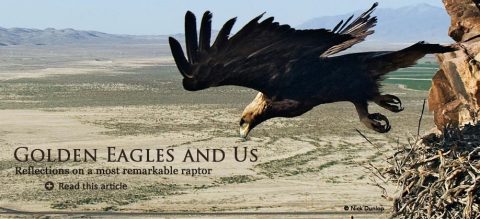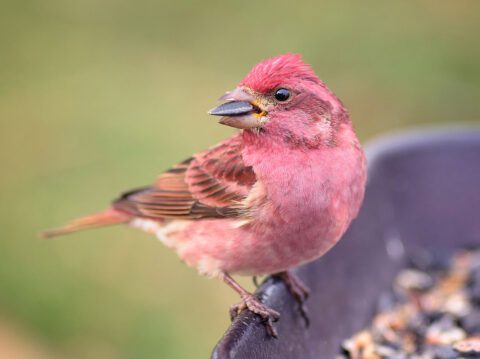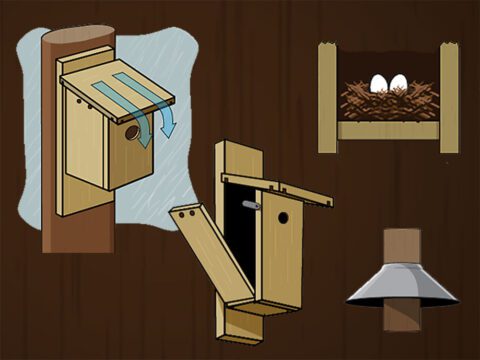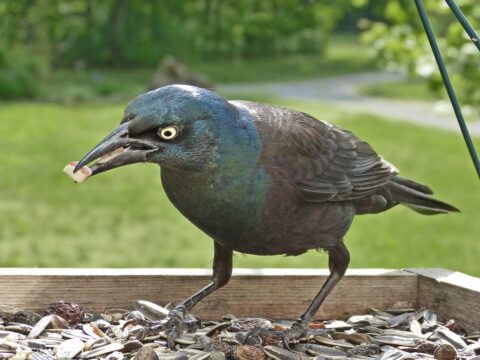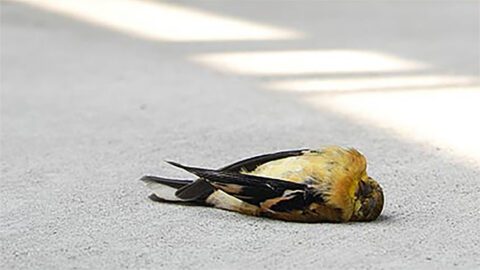Golden Eagles and Us
Text by Grainger Hunt; photos by Nick Dunlop
April 15, 2009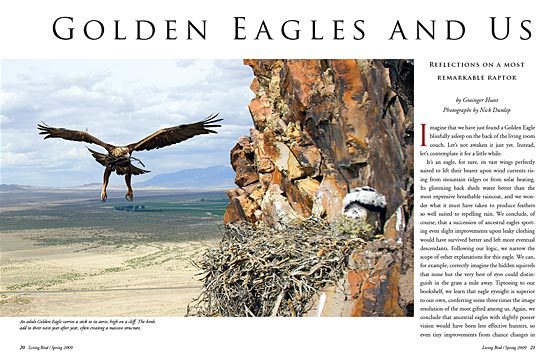
Imagine that we have just found a Golden Eagle blissfully asleep on the back of the living room couch. Let’s not awaken it just yet. Instead, let’s contemplate it for a little while.
It’s an eagle, for sure, its vast wings perfectly suited to lift their bearer upon wind currents rising from mountain ridges or from solar heating. Its glistening back sheds water better than the most expensive breathable raincoat, and we wonder what it must have taken to produce feathers so well suited to repelling rain. We conclude, of course, that a succession of ancestral eagles sporting even slight improvements upon leaky clothing would have survived better and left more eventual descendants. Following our logic, we narrow the scope of other explanations for this eagle. We can, for example, correctly imagine the hidden squirrels that none but the very best of eyes could distinguish in the grass a mile away. Tiptoeing to our bookshelf, we learn that eagle eyesight is superior to our own, conferring some three times the image resolution of the most gifted among us. Again, we conclude that ancestral eagles with slightly poorer vision would have been less effective hunters, so even tiny improvements from chance changes in the genes controlling eye development over the millennia would have left more copies. For eagles, the gradual march toward better and better eyesight was pushed to the limit. Notice that nature did not push our own eyesight to such a limit (the brain has just so much room), but it pushed other aspects in our makeup to comparably advanced dimensions—among them our wonderful ability to reflect upon all this.
Still tiptoeing, we open the window near the couch and, speaking softly, we ask our eagle if he might be happier outside. The bird agrees and, after glancing disdainfully around, he launches himself through the opening and glides down the hill, his speed increasing until thermals begin bearing him up into the welcome sunshine. As he circles higher and away, we somehow manage to continue observing his activities, and even to know his disposition. We notice the haste in his departure, an anxiety focused not so much on getting away but rather on what may have happened during his absence from his territory and his mate.
Sure enough, as he arrives at his aerie on the great cliff on the distant mountain, he finds that another eagle has taken his place. Our bird knows this usurper as the very one who trespassed numerous times in the past and required the utmost effort to evict. For nearly 20 minutes, the two eagles vigorously pursue one another, stooping and grappling across the vast sky, until finally the newcomer gives up and leaves.
Our eagle was so eager to risk everything to regain his territory because an eagle without a territory cannot reproduce. Looking for another cliff and another mate might seem (to us) preferable to the danger of fighting, but eagles are prosperous in this region, and inevitably there are no unowned cliffs that could suit our eagle’s purpose. But more to the point, there have been few ancestral quitters. On the contrary, our eagle has descended from a long line of scrappy, hard-headed, tenacious eagles, eagles with grit, eagles for whom reproduction was always the main element in their design, the central issue around which all other functions were secondary. Indeed, our eagle is a product of an unbroken line of successful reproducers extending back some three billion years to the first strands of replicating molecules. Our eagle does not have a single unsuccessful ancestor.
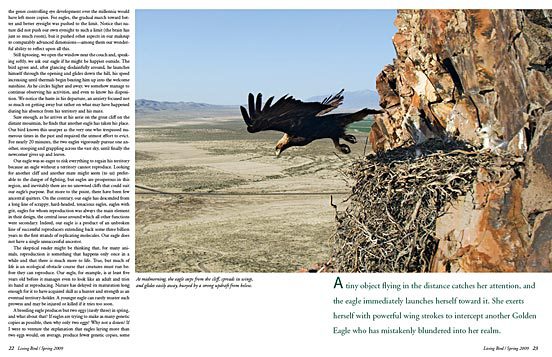
The skeptical reader might be thinking that, for many animals, reproduction is something that happens only once in a while and that there is much more to life. True, but much of life is an ecological obstacle course that creatures must run before they can reproduce. Our eagle, for example, is at least five years old before it manages even to look like an adult and tries its hand at reproducing. Nature has delayed its maturation long enough for it to have acquired skill as a hunter and strength as an eventual territory-holder. A younger eagle can rarely muster such prowess and may be injured or killed if it tries too soon.
A breeding eagle produces but two eggs (rarely three) in spring, and what about that? If eagles are trying to make as many genetic copies as possible, then why only two eggs? Why not a dozen? If I were to venture the explanation that eagles laying more than two eggs would, on average, produce fewer genetic copies, some might accuse me of using that same old circular argument. Prove it, they would say, and quite reasonable they would be. And that is what biologist David Lack began doing in the 1940s. He noticed that starlings laid as many as 10 eggs, but with careful observation he found that greater numbers of young survived from nests of four or five eggs than from nests with many more. Lack’s idea was that birds have as many young as they can nourish, but scientists have since come to understand that clutch size interrelates with other adaptations that nature choreographs in the direction of having as many offspring as possible surviving over a lifetime of effort. And so it is with eagles.
And so with us? Yes indeed. We too are contestants in an evolutionary race for genetic representation. And yet today, average family sizes in many modern countries, particularly those in the United States, Europe, and Japan, are considerably smaller than one would expect on the basis of food availability. This gift to our planet stems from recent, extraordinary changes in the fortunes of women. Education, freedom from male domination, and medical advancement are presenting women with unprecedented opportunities to choose between their rational and evolutionary identities, a development that could provide an eventual escape from overpopulation and its debilitating effect on both society and nature.
Meanwhile, our eagle pair still perches on their rocky crag overlooking a vastness of grassy hills, our city in the distance. At midmorning, the male steps from the cliff, spreads his wings, and glides easily away, buoyed by a strong updraft—his purpose to hunt squirrels on the windy slopes below. Mother remains near her half-grown son in the great nest of sticks that she and her predecessors have kept in repair these 500 years. She meticulously preens each of her flight feathers and watches the vast theater of landscape within her vision. A tiny object flying in the distance catches her attention, and she immediately launches herself toward it. Unlike the male’s lazy, energy-saving glide toward the squirrels, she exerts herself in powerful wing strokes to intercept another Golden Eagle who has mistakenly blundered into her realm. She soon has it retreating, and when satisfied it is gone, she returns to her nest.
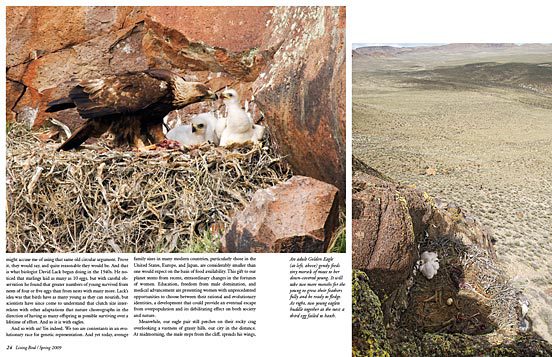
Perched nearby is a raven, who chides the mother eagle for being so unfriendly toward that perfectly nice visitor, who was just being social.
“Really, do you think so?” asks the eagle. “My instinct is to repel all intruders.”
“That’s old fashioned,” scoffs the raven. “We must learn to share.”
And so the eagle passes the sage raven’s remarks on to her husband, and both agree to let other eagles hunt within the territory, though the latter are not welcome to perch near their nest. Soon, there are a half-dozen new eagles coursing back and forth over the hills in search of squirrels. All seems fine, for a few days. Then father eagle begins noticing fewer and fewer squirrels out and about. The ones that haven’t been eaten are now overly cautious and impossible to catch. And so, not surprisingly, the pair summarily evicts all their guests, a project that nearly wears them out. Sometimes, they conclude, being nice isn’t such a good idea.
Meanwhile, the perplexed, well-meaning, busybody raven continues to reflect upon ways of bringing about a utopia among the eagles. “Have fewer offspring,” he concludes. “If all eagles were to collectively adjust their fecundity below the level of density-feedback [he’s done some reading!], the world would be large enough and rich enough for all eagles to enjoy lives of relaxed fulfillment.” The raven sighs, overwhelmed by the prospect of convincing even a fraction of the world’s eagle population to pursue this simple, relatively gentle, and universally effective solution to the inequities of competitive strife.
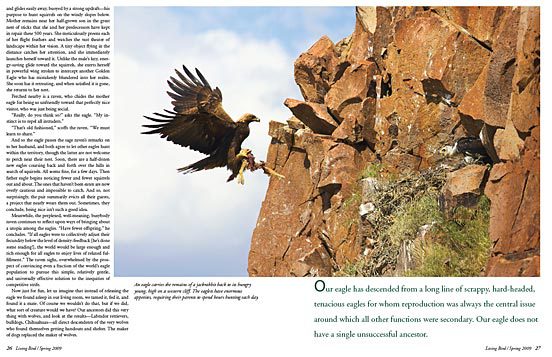
Now just for fun, let us imagine that instead of releasing the eagle we found asleep in our living room, we tamed it, fed it, and found it a mate. Of course we wouldn’t do that, but if we did, what sort of creature would we have? Our ancestors did this very thing with wolves, and look at the results—Labrador retrievers, bulldogs, Chihuahuas—all direct descendents of the very wolves who found themselves getting handouts and shelter. The maker of dogs replaced the maker of wolves.
What might result if the maker of eagles were to be replaced? Would descendents cease to be eagles? When did wolves cease to be wolves? Were they dogs, despite their appearance, the moment they made friends with humans? Is a wolf still a wolf indoors? Is an eagle an eagle without the wind, without other eagles to chase from its territory, or without squirrels to pursue? Is a polar bear a polar bear without the sea ice—a human being a human being on a space station or at a mall?
Twelve thousand years or so ago, some of our ancestors forsook their jobs as nomadic hunters and gatherers and moved from prairies and woodlands to farms and thence to towns and cities. They replaced the environmental template that created them with other templates, in some ways less demanding, in other ways more so. Most of us now find ourselves sealed off from nature, having domesticated ourselves to the point of disconnect from our design. And yet the design itself is slow to change. Dogs, despite the myriad transformations in their appearance during the 15,000 years since they were first domesticated, differ genetically from wolves by only two-tenths of one percent. Wolves, in contrast, differ from their other closest relative, the coyote, by 10 times that difference. The world of the dog is not yet the perfect template of its design, nor is ours, considering the very small number of genetic changes that could have taken place in the short period since humans began staying put. Thus the world we now live in is not the world that designed us, and yet our instinct is to behave as though it was.
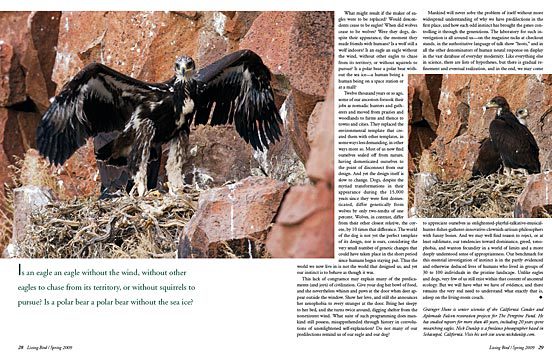
This lack of congruence may explain many of the predicaments (and joys) of civilization. Give your dog her bowl of food, and she nevertheless whines and paws at the door when deer appear outside the window. Show her love, and still she announces her xenophobia to every stranger at the door. Bring her sleepy to her bed, and she turns twice around, digging shelter from the nonexistent wind. What suite of such programming does mankind still possess, misapprehended through history in convolutions of unenlightened self-explanation? Do not many of our predilections remind us of our eagle and our dog?
Mankind will never solve the problem of itself without more widespread understanding of why we have predilections in the first place, and how each odd instinct has brought the genes controlling it through the generations. The laboratory for such investigation is all around us—on the magazine racks at checkout stands, in the authoritative language of talk show “hosts,” and in all the other denominators of human neural response on display in the vast database of everyday modernity. Like everything else in science, there are lists of hypotheses, but there is gradual refinement and eventual realization, and in the end, we may come to appreciate ourselves as enlightened-playful-talkative-musical-hunter-fisher-gatherer-innovative-clownish-artisan-philosophers with funny bones. And we may well find reason to reject, or at least sublimate, our tendencies toward dominance, greed, xenophobia, and wanton fecundity in a world of limits and a more deeply understood sense of appropriateness. Our benchmark for this essential investigation of instinct is in the partly evidenced and otherwise deduced lives of humans who lived in groups of 30 to 100 individuals in the pristine landscape. Unlike eagles and dogs, very few of us still exist within that context of ancestral ecology. But we will have what we have of evidence, and there remains the very real need to understand what exactly that is, asleep on the living-room couch.

All About Birds
is a free resource
Available for everyone,
funded by donors like you
American Kestrel by Blair Dudeck / Macaulay Library
